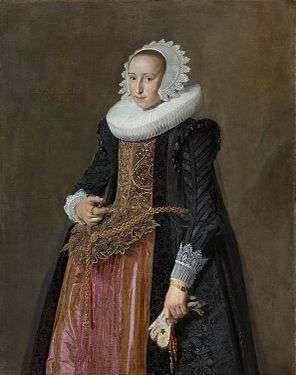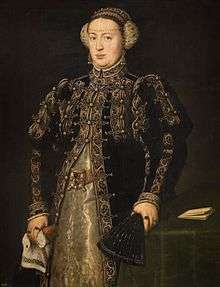Vlieger (cape)

Portrait of Aletta Hanemans wearing a black vlieger with attached sleeves, by Frans Hals
A vlieger is a type of sleeveless over-gown or cape worn by women in the late 16th and early 17th-centuries.[1] Variations with short sleeves or high shoulder rolls are known.[2] Sometimes sleeves were attached with aiglets, and often slits were made to allow belts or the hands to pass through.[3]
In the Netherlands the vlieger was often worn with a millstone collar (a wide starched ruff).[1] The vlieger was always worn with a skirt with a fardegalijn. In cold weather it could be buttoned shut, though the Spanish version, called a "ropa" could only be closed at the neck.
The Spanish version was called a "ropa" and the French version was called a "marlotte".[4]
 Margaret of Parma with ropa, c 1559
Margaret of Parma with ropa, c 1559 Infanta Caterina with ropa, c. 1552
Infanta Caterina with ropa, c. 1552 A woman aged 24 with vlieger, 1587
A woman aged 24 with vlieger, 1587 French Noblewoman with marlotte, 1560-9
French Noblewoman with marlotte, 1560-9
References
- 1 2 de Winkel, Marieke (2006). Fashion and fancy : dress and meaning in Rembrandt's paintings. Amsterdam University Press. pp. 77, 353. ISBN 9789053569177. OCLC 56806897.
- ↑ "Vlieger". Instituut voor de Nederlandse Taal. Retrieved 2016-12-12.
- ↑ "Cultuurwijs - Kleding in de Barok: 1600 - 1625". www.cultuurwijs.nl. Retrieved 2016-12-12.
- ↑ 20,000 Years of Fashion: The History of Costume and Personal Adornment, by Francois Boucher (art historian) & Yvonne Deslandres, 1987, pp. 224-225
| Wikimedia Commons has media related to Vlieger (cape). |
This article is issued from
Wikipedia.
The text is licensed under Creative Commons - Attribution - Sharealike.
Additional terms may apply for the media files.